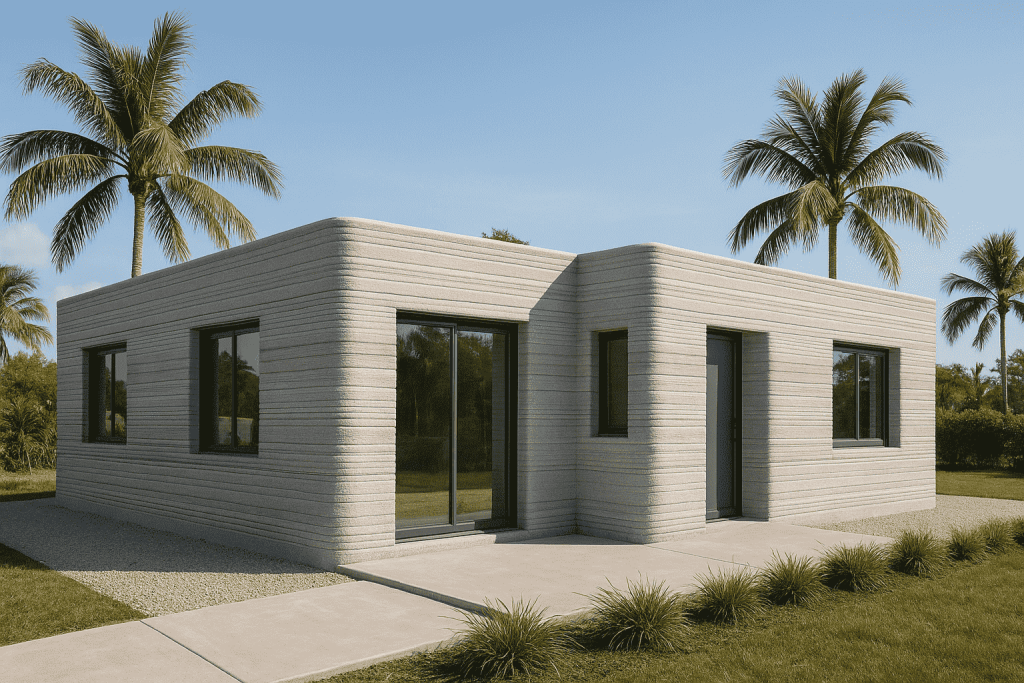Only a decade ago, 3D printing in construction in Florida sounded like science fiction — a futuristic vision where robots poured concrete instead of workers. Today, that future has arrived, and nowhere is it more promising than in Florida. With its rapid population growth, demand for affordable housing, and challenging climate, the state has become a perfect testing ground for 3D-printed homes.

From Innovation to Implementation: 3D Printing in Construction in Florida
3D printing, or additive manufacturing, builds structures layer by layer using a specialized concrete mixture. The process eliminates the need for traditional formwork, reduces material waste, and allows for faster, more precise construction. Early projects were small-scale experiments — sheds, cabins, prototypes. But by 2025, companies across the U.S. are completing entire communities built by robotic printers.
Florida has already seen several milestones. Startups and established builders are working together to create hurricane-resistant homes printed in under a week. These are not temporary shelters but fully functional, energy-efficient houses designed to last for generations.
Speed, Efficiency, and Cost
The greatest advantage of 3D printing is time. A typical small home can be printed in less than 72 hours of machine operation. Labor costs drop dramatically because most of the process is automated. Material efficiency increases, since printers use exactly what is required — no excess concrete, no leftover waste.
This precision translates into affordability. While luxury markets often focus on aesthetics and innovation, 3D printing opens the door to something even more valuable: accessibility. Learn more about our sustainable architecture trends. It offers the possibility of high-quality, hurricane-resistant housing for middle-class families without sacrificing design or durability.
Resilience for a Changing Climate
Florida’s environment presents unique challenges — humidity, heat, storms, and salt air. Traditional construction often struggles to keep pace with maintenance demands. 3D-printed homes, however, are being engineered with resilience in mind.
The concrete mixtures used in modern printers contain advanced additives that resist corrosion and mold growth. Wall designs include curved, aerodynamic shapes that disperse wind pressure during storms. Some companies are experimenting with hydrophobic coatings and integrated drainage channels that prevent water damage even in flood-prone areas.
In this sense, 3D-printed construction is not only a cost-saver but a survival strategy for coastal architecture.
Architectural Freedom Without Limits
For architects, 3D printing represents a liberation from geometry. Traditional methods require right angles, fixed panels, and repetitive forms. A printer, however, can draw almost any shape — from organic curves inspired by coral reefs to intricate lattice structures that play with light and shadow.
This flexibility allows for unprecedented creativity in custom home design. Walls can flow like waves; roofs can open to capture sunlight. Every project becomes a fusion of art and engineering, shaped by algorithms and executed by machines with millimeter precision.
Sustainability at Its Core
Additive construction aligns perfectly with global sustainability goals. Because the process uses less material and energy, its carbon footprint is lower than that of traditional building methods. Some pioneers are experimenting with local materials — recycled sand, crushed shells, and even carbon-capturing cement — turning each build into a small step toward ecological responsibility.
The combination of sustainability and digital design makes 3D-printed homes not just environmentally friendly but symbolically powerful. They represent a new kind of craftsmanship — one where human creativity meets robotic precision to produce something both efficient and emotional.
Florida’s Emerging 3D Printing Ecosystem
Several Florida-based developers have become early adopters of the technology. In regions like Orlando and Tampa, collaborations between tech startups and universities are accelerating innovation. Entire neighborhoods are being planned with 3D-printed homes that include solar roofing, smart climate systems, and energy storage.
Local governments are beginning to adapt building codes to support this transformation. As permitting catches up with innovation, Florida could soon lead the nation in the large-scale deployment of printed housing.
Challenges Along the Way
Despite the excitement, 3D-printed construction still faces obstacles. Printers are expensive, and the technology requires specialized training. Building inspectors and municipalities must learn how to evaluate these unconventional structures. Supply chains for printing materials are still developing, and the design software demands new kinds of expertise.
Yet, as with all disruptive technologies, early challenges give way to long-term gains. As equipment becomes cheaper and regulations clearer, 3D printing will likely move from the experimental edge to the mainstream of construction practice.
A Glimpse Into the Future
Imagine driving through a Florida neighborhood where each home is uniquely shaped — some resembling shells, others designed for airflow and shade — all printed in days instead of months. Imagine construction sites that are quiet, clean, and automated, where humans oversee robots rather than operate heavy machinery.
That vision is not decades away. It is unfolding now. The homes built in Florida today are prototypes for the world that will come tomorrow — one where we build not faster or cheaper alone, but smarter, cleaner, and more human.

